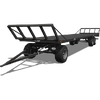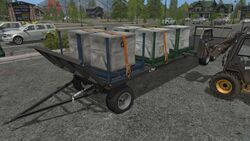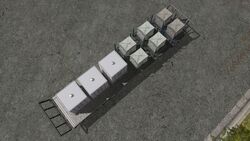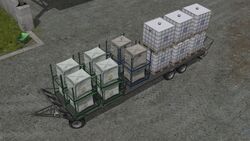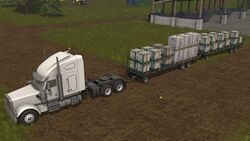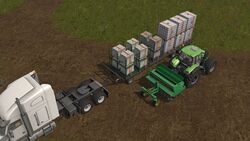Bale Trailers/Farming Simulator 17
A Bale Trailer (or Flatbed) is a type of trailer in Farming Simulator 17. The Bale Trailer is a simple flat platform on wheels, with a hitch that can be attached to a Vehicle. Immobile objects can be placed on the Bale Trailer's platform, and then be quickly transported from one place to another.
Bale Trailers are best used for two types of cargo: Bales and Pallets. A large number of these objects can be stacked on a single Bale Trailer, and transported en-masse to another location. Additionally, a Bale Trailer can be used to transport Logs, although loading a large number of them onto this trailer is difficult (see Log Transports).
As an added bonus, the Bale Trailer features a number of Tension Belts that can hold the cargo in place - making it completely impossible for the cargo to fly off during a sharp turn or sudden braking.
Bale Trailers are unrivaled in the field of transporting Pallets - they absolutely dominate this role. As far as Bales go, Bale Trailers are significantly inferior to Bale Collectors. Similarly, they have considerable disadvantage compared to Log Transports when it comes to carrying Logs.
Farming Simulator 17 features only one model of Bale Trailer.
List of Bale Trailers
Below is the only model of Bale Trailer available in the base game. It is found in the "Baling Technology" category at the store - although it is not at all limited to carrying Bales.
| Name | Price | Maint. Cost per Day |
Platform Surface Area |
Hitch | Weight |
|---|---|---|---|---|---|
| Fliegl DPW 180 | 12,000 | 10 | 10.5 x 2.5 | Drawbar (Bolt) | 5,033 |
Loading Bale Trailers
The job of a Bale Trailer is to carry objects from one place to another rapidly. To do so, the objects must be placed on the Bale Trailer, and optionally (but preferably) strapped down with tension belts. Multiple objects can be placed on a single Bale Trailer - you are only limited by the weight (based on the power of the vehicle you intend to use to tow this cargo) and height (how high you can stack the cargo).
A Bale Trailer is a very simple device, and has no method of automatically loading itself. Instead, another vehicle must be used to lift the cargo and place it down on the Bale Trailer's platform.
Once the cargo is loaded, it's advised to use tension belts to strap it down.
Note that Bale Trailers can only carry solid objects. It is not possible to dump materials onto the platform (e.g. Crops, Silage, Wood Chips, and so on).
Loading with a Loader
The best vehicles for loading a Bale Trailer are Loaders, which are specifically designed for lifting all types of cargo. With the correct tool installed on it, any type of Loader can place cargo on a Bale Trailer.
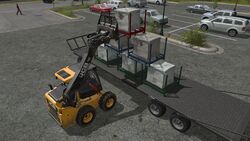
The best Loaders for this job are Skid Steer Loaders and Telehandlers. Skid Steers have superior maneuverability and precision, and can complete the loading job in a very short time once you develop your skill in using them. Telehandlers are slightly less maneuverable, but their main advantage is that they can lift the cargo very high above the ground - potentially stacking many objects on top of one another.
Unsurprisingly, Pallet Forks are the best tools for working with Pallets, Bale Forks for Bales, and Log Forks for Logs, but in the right hands it is possible to use multiple different tools for multiple types of cargo.
Arranging the Cargo
It is often best to start loading from the front end of the Bale Trailer (the part closest to the hitch). If there is too much cargo at the rear of the platform, the trailer will lose stability when driving around, particularly during sharp turns. Putting the cargo at the front stabilizes the trailer relative to the towing vehicle.
Try to pack Pallets and Bales as close to one another as possible. The less space each pallet/bale takes up on the trailer, the more of them can be carried simultaneously. Do your best to load the trailer at a perpendicular angle, to ensure that each object takes as little space as possible.
Remember that Pallets are about half as wide as the Bale Trailer model available in the base game. When loading pallets, you can put two of them side-by-side on the Bale Trailer, if you do it carefully.
Tip: You can use the Bale Trailer's tension belts to mark the best places to put them. When the Bale Trailer is attached to a vehicle, you can toggle all Tension Belts instantly by using a single hotkey. When not attached, you can manually fasten each belt independently by walking up to individual belt fasteners on the Bale Trailer and pressing the correct hotkey. When it's time to load the Bale Trailer, toggle all belts on, showing you where to place each object. Later, when the cargo is in place, toggle all belts off and on again to fasten them to the cargo itself. This trick is less useful for Bales or Logs, but the belts can still give you some indication of where best to place them.
Stacking
It is quite possible - and often desirable - to stack your cargo objects on top of one another.
With a Skid Steer Loader, it is possible to create two layers of Pallets on top of a Bale Trailer, or at least 3 layers of Bales. Logs, of course, can also be stacked, but this is much more difficult, and the maximum stack size depends on the width of each individual log.
With a Telehandler, it is technically possible to create very high stacks, as long as you have the skill necessary to stack that high without causing the entire stack to collapse. A Telehandler should be able to make a Pallet stack 6 layers tall.
However, even if you're very good at stacking, stacking too high is a danger in and of itself. For starters, each additional layer of objects raises the center-of-mass of the Bale Trailer up above the ground. Raise it too high, and the Bale Trailer will almost certainly flip over the moment you make a turn at more than a few km/h. Try to stay within the constraints of 2 Pallet layers or 3 Bale Stacks - or alternatively, drive very slowly and carefully.
Furthermore, the Tension Belts of the Bale Trailer model available in the base game can only stretch up to the height of 4 layers of Pallets. Any additional pallets stacked on top of that will not be held down by the Tension Belts, and are likely to fly off the Bale Trailer as soon as you make a sharp turn!
Weight Limit
Although there is no hard limit to the amount of weight you can pile onto a single Bale Trailer, you have to remember that the Bale Trailer will need to be towed around by a vehicle. The more cargo you pile onto the Bale Trailer, the harder it will be to move the whole thing.
The Bale Trailer model available in the base game weighs 5 tons when empty. Different types of cargo have different weights, but for example a full Seed BigBag weighs at least 200 kg, whereas a Poplar Saplings Pallet seems to weigh closer to 500 kg at least. Loading too many on a single Bale Trailer will make it impossible for some vehicles - possibly even some Trucks - to pull the entire thing.
Furthermore, the more weight you pile onto a single Bale Trailer, the less stable it becomes. This is especially true if you've stacked the cargo very high (see prev. section). However even low-stacked heavy cargo can make the Bale Trailer unstable during sharp turns.
Tension Belts
After your cargo is loaded, it is best to toggle on all of the Tension Belts. To do this, hook up the Bale Trailer to a vehicle, and hit the special hotkey to toggle all of the belts. If the belts do not appear, hit the same button a couple more times.
Alternatively, you can walk up to each individual belt fastener on the platform itself, look directly at it, and hit the appropriate button. This will fasten only that specific belt. Remember that the Bale Trailer available in the base game has a total of 6 belts, which you'll need to fasten individually.
Tension Belts are automatically adjusted to the height and shape of your cargo. They can fasten relatively high stacks of objects - roughly 4.2 meters above the platform. Any object stacked higher than that will not be held down by the Tension Belts, and is at risk of flying off as soon as any sudden force is applied to it.
After fastening the tension belts, make sure to inspect your cargo visually to check whether it is properly held down. If any object is not fastened, it is likely to fly off. In this case, release all of the belts, adjust your cargo with the Loader, and try again.
Towing a Bale Trailer
The only Bale Trailer model in the base game has a Drawbar (Bolt) attachment at the front. This can be connected to almost any vehicle in the game.
Bale Trailers are meant to move cargo quickly from one place to another, so you'll likely want a rather fast vehicle to tow your Bale Trailer. On the other hand, the weight of a Bale Trailer can be substantial if it is carrying a lot of cargo, so you'll also want the towing vehicle to be strong enough to pull it.
Therefore, choosing which vehicle to tow your Bale Trailers with is a matter of balancing speed and power. Typically, a Truck is the optimal vehicle to tow Bale Trailers. Remember that Trucks need to be upgraded with a "Back Attacher" in order to be able to connect to a Drawbar (Bolt).
If you need more speed and your cargo is light, consider using a Car instead of a Truck.
Remember to be very careful when making turns with a Bale Trailer. Even if the cargo is properly strapped down with Tension Belts, the mass of the Bale Trailer is typically far off the ground (especially when the cargo is stacked high), and it can easily flip over at high speed. If the cargo is particularly heavy, any wrong move can flip it over. The heavier or taller your cargo, the more carefully you need to pull it.
Bale Tailer Chains
Much like Tippers, Bale Trailers typically have the same type of attachment point at the front as they do at the back. This means that a Bale Trailer can be attached to another Bale Trailer, forming a "chain" (also known as a "Road Train"). A single vehicle can then tow two or more Bale Trailers at the same time.
Hitching a chain using the Bale Trailer available in the base game is somewhat difficult, because it has a swivel arm at the front which is very difficult to control when driving in reverse. However it is doable with some patience.
With two or more trailers hitched this way, you can split the cargo between them, making each trailer more stable and allowing you to drive a little faster. Once again, concentrating your cargo at the front end of each trailer makes them more stable overall.
Be careful not to put too much cargo on your trailers just because you have two of them. Even a powerful Truck can have problems towing more than one fully-loaded Bale Trailer.
Unloading a Bale Trailer
Bale Trailers do not have any mechanism to unload themselves. They must be unloaded using other machines. Alternatively (as described in the next chapter), a Bale Trailer carrying specific types of cargo can be used as a Mobile Filling Point for machines to come to when they need refilling, in which case you do not need to unload it at all.
Unloading with Front Loaders
The primary way to unload a Bale Trailer is to use the same machines you used to load it - Loaders. Once again, while all Loader types are capable of this sort of work, Skid Steer Loaders and Telehandlers are the most suitable.
Unloading is a little easier than loading, since you do not need as much precision. In fact, you could even use the Loader's tool to just shove the cargo off the Bale Trailer. If you want to by tidy, or arrange your cargo on the ground in a way that doesn't take too much space, it's better to do it slowly and carefully. Skid Steer Loaders are very precise, and can stack cargo on the ground just as easily as they can stack it on the Bale Trailer itself.
If you find that you are unloading a lot of cargo in a specific place very often, consider buying a Skid Steer Loader to put in that location just for that job. Skid Steer Loaders and their tools are very cheap and have very low Daily Maintenance Costs.
Note: Remember to open the Tension Belts before attempting to unload the cargo. You will not be able to move any cargo that is strapped to the Bale Trailer.
Unloading with Physics
For a "cheesier" and riskier but much faster method of unloading, you can use physics to get your cargo off the Bale Trailer.
To do this, get your Bale Trailer close to where you want to unload and unfasten the Tension Belts. Speed up towards the unloading point, and make a very sharp turn to one side. If you do this correctly, the cargo will simply fly off the Bale Trailer and spread out on the ground.
This is by far the messiest way to unload any cargo, and you run the risk of flipping your Bale Trailer and/or towing vehicle. It is not a recommended way to unload anything.
Mobile Filling Point
It is not always necessary to unload your Bale Trailers at all. Certain types of pallets (Seed BigBags, Solid Fertilizer BigBags, Liquid Fertilizer Tanks, Poplar Saplings Pallets or Pallet Saplings) can be used while they are still on the Bale Trailer, even if they are still strapped down.
To use them, simply bring the appropriate machine (a Sowing Machine, Fertilizer Spreader, Sprayer or Tree Planter, respectively) to the Bale Trailer carrying this cargo. When the machine gets close enough to the pallets sitting on the Bale Trailer, you'll get the option to refill directly from these pallets. Alternatively, you can tow the Bale Trailer to the machine on the field, and refill it there.
With this method, you can load your Bale Trailer with a lot of cargo required for field work, and tow it to a central location near your fields, so that your machines will have a place nearby to be refilled. This can save a lot of back-and-forth trips to get your machines filled with the necessary materials. You can use separate trailers for each type of cargo, or mix pallets of different types on the same bale trailer - whichever you prefer.
Comparison with other Machines
Bale Trailers are the only real method to move Pallets from place to place. While you could do it one or two pallets at a time by loading them into a Car, this is highly inefficient and incomparable to a Bale Trailer, which can move dozens of pallets in one go.
However when discussing Bales and Logs, while Bale Trailers can perform both jobs, they are not the best tools for either job.
Bales are best transported by Bale Collectors. The primary advantage of a Bale Collector is that it can load its own bales automatically, in a process that is exceptionally fast compared to loading bales one-by-one on a Bale Trailer. Furthermore, a Bale Collector can dump its carried Bales in a tidy stack with just a press of a button. The entire process of loading and unloading a Bale Collector is very simple, requires very little skill, and takes very little time.
The best way to transport Logs is with a Log Transport. For one, a Log Transport has tall spikes on both sides to hold the logs in, keeping them from rolling off the platform. Secondly, most models of Log Transports in the game have their own lifting arm that can load logs onto the platform much more easily than a Log Fork could. They also have the same kind of Tension Belts found on a Bale Trailer.
While these machines are better than a Bale Trailer at their respective jobs, it's important to remember that a Bale Trailer is always a far cheaper option.

